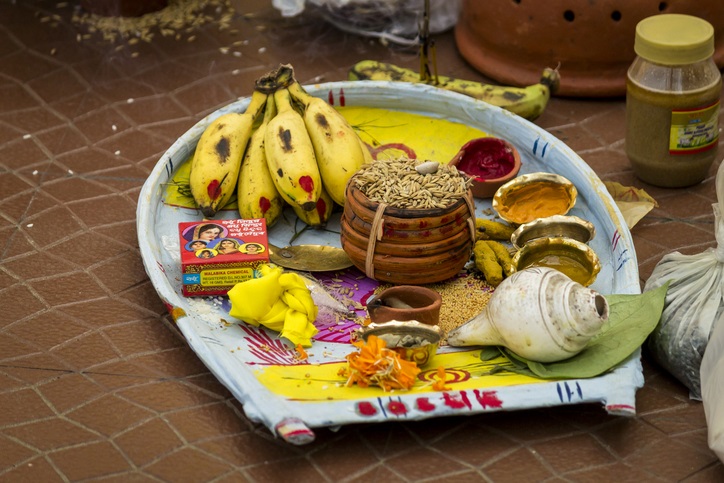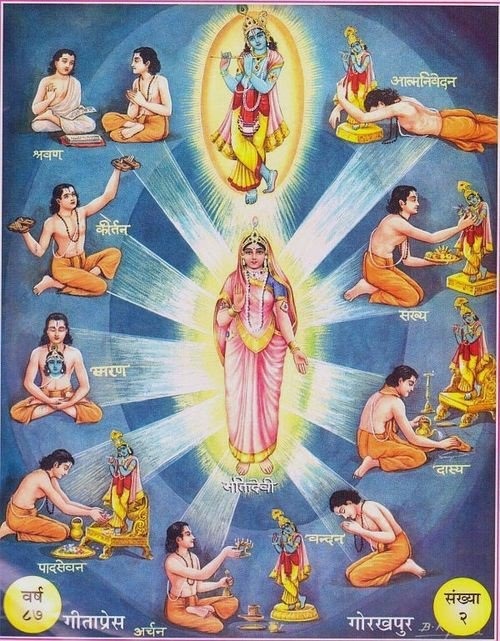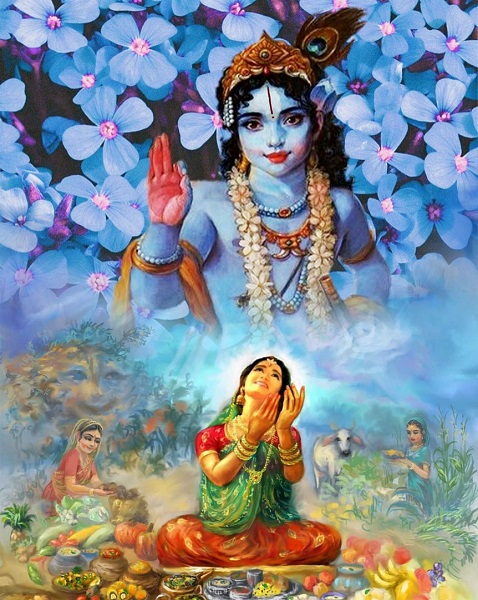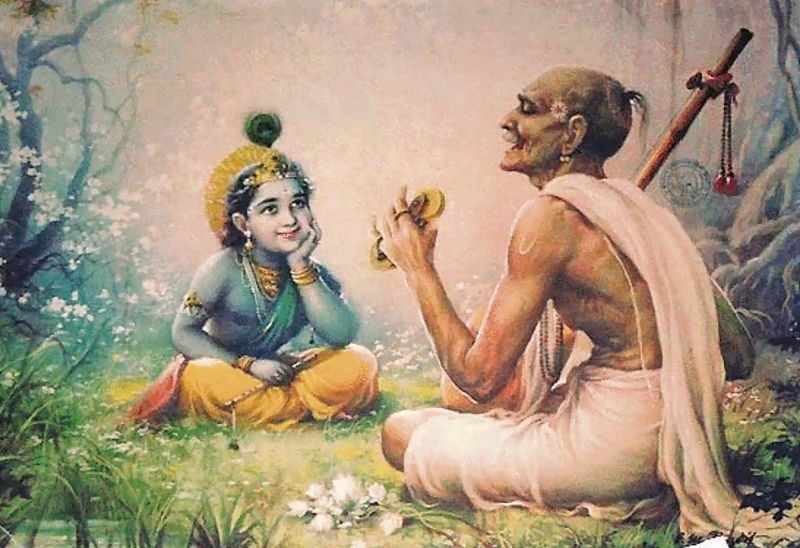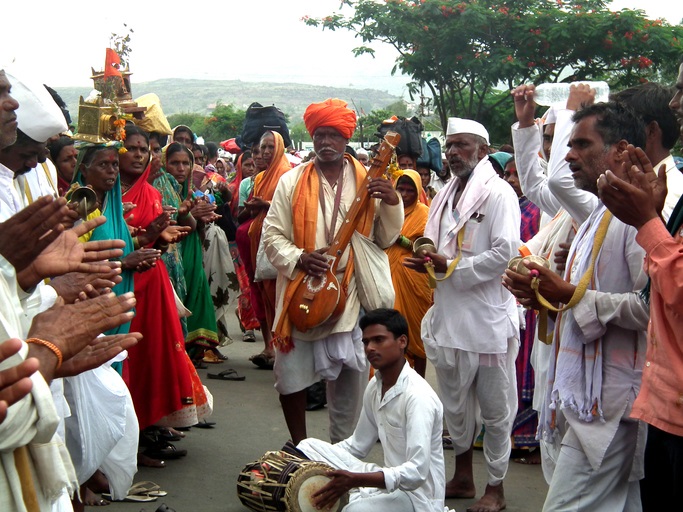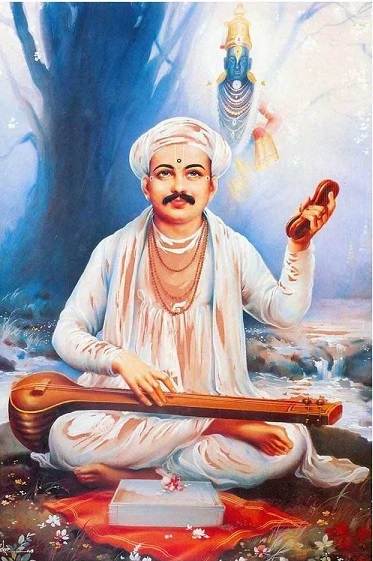In the Hindu tradition, pujā or worshiping God is a key concept of every Hindu’s life.1 In daily life, everyone should perform pujā of the God or Goddesses for attaining peace of mind. This worship needs some utensils, flowers, incense, etc. A devotee is supposed to make some offerings to the deity. There is a tradition of worship through 16 different offerings to God and it is called SodaṢopchar pujā.2 At the same time, Hindu tradition introduced another aspect of the worship of God called Mānas Pujā.3 Scholars and saints considered this concept of Mānas Pujā very auspicious as well as spiritual.
This paper deals with the importance of Mānas Pujā. While dealing with this concept, I have tried to explain the concepts of bhaktī, Puja as one of the eminent acts of Upāsanā and then Mānas Pujā one by one.
Every individual has a natural urge for light, bliss, freedom, knowledge, immortality, etc. This urge motivates him towards the way of self-liberation from the materialistic world. For this particular achievement, he needs to surrender himself to the Supreme Power or the Ultimate Reality of the Universe. This act shows him the path to reach his goal which is called Upāsanā. The word Upāsanā is derived from up (उप) means near and aas (अस) means to seat. By seating near God, one is able to achieve the ultimate goal of his own life.4 ‘Upāsanā ‘ in Sanskrit means “sitting near” but normally the term is used in Hinduism to denote a prescribed method for approaching a deity or God or getting close to deity/deities. In the Vedas, some Upāsanā’s are prescribed whereby one meditates on the all-pervading Brahman as some aspect of creation, such as fire, water, directions, food, mind, joy, etc. Thus, Upāsanā can be described as a systematic practice of a prescribed method of worship for pleasing and winning the attention of the deity or it can be a deity-less practice of austerities involving meditating upon some aspect of nature as told in specific Vedic Upāsanā. Normally such prescriptions of worship or meditation methods are taken from various Hindu scriptures, mainly the Purān̥as and Vedas. A devotee would consult the scriptures, or a person who knows them thoroughly, to get a prescribed form of worship (Upāsanā) for his/her deity of choice (Ishta Devatā) and follow it faithfully to the best of his/her abilities.
(Figure 1: Credit: Istock – A Thali containing sacred items for puja)
In Hindu religion and culture; Upāsanā or bhaktī has importance in everyone’s life. To love God intensely is called bhaktī. This is a state of mind. The word bhaktī is derived from the Sanskrit root bhaj भज means Seva or Upāsanā. (P.352)5
How does this love towards the divine manifest itself? The scripture of S̀rimad Bhāgavatam̥ (7.5.23), delineates the nine ways (Navavidhā bhaktī ) in which we can lovingly connect with God: They are as follows-
(Figure 2: Credit: Facebook – Navavidhā bhaktī)
श्रवणं कीर्तनं विष्णो :स्मरणं पादसेवनं अर्चनं वन्दनं दास्यं सख्यं आत्मनिवेदनम् |
sravaṇam̥ kirtanaṃ̥ visnoh smarạnam̥ pāda-sevanam̥ arcanam̥ vandanam̥ dāsyam̥ sakhyam̥ ātma-nivedanam̥
1). Hearing about God (Shravana)
2). Chanting His Name and Glory (Kirtana)
3). Remembering Him (Smarana)
4). Serving His Lotus Feet (PadaSevana)
5). Worshipping Him as per the Scriptures (Archana)
6). Prostrating before Him (Vandana)
7). Being His Servant (Dasya)
8). Befriending Him (Sakhya)
9). Offering Oneself to Him (AtmaNivedana)
These are the nine ways in which one can relate to God. We are free to select the particular connection with God which suits the temperament and nature of our minds. In Āatma Nivedanam one should offer everything to God including our body, mind, and soul. One should not have any personal and independent existence. One should leave all the karmas, dharma and offer oneself completely to Him.
In the Sadinilya bhaktī Sutra, bhaktī means that which is affection and love for God.
अथातो भक्तिजिज्ञासा| सा परानुरक्तिरीश्वरे|| 1.1.1-2
(Athāto bhktijijñāsā | sā prānurkatirīshvare)
One of the methods to express our bhaktī or devotion towards God is called pujā /worship.
In the Rig̥veda, sages mentioned the importance of worshipping Lord Vishnu- He have ye satisfied, singers, as well as ye know, a primeval germ of order even from his birth, Ye, knowing his name, have told it forth, may we Vishnu enjoy the grace of the mighty One.6
As mentioned earlier, Bhāgvat Purān̥am̥ gives one way of offering bhaktī to God as Pujā or worship of the ultimate reality. In India, this is called Dev Pujā. The word Dev pujā occurs in the text of the Vartika on the Panini’s text As̥tādhȳayī. (Chapter XIX) 1.3.25
In Rāmāyan̥, Mahābhārat we find different references of Devpujā.7 The Word pujā is derived from the root pujā means (in India particularly) ceremonial worship of a Hindu deity including rituals and offerings. Pujā is used to denote a ritual of worship of an idol of a deity which is considered as possessing special power and being sacred. In India, devotees perform different pujā’s like Sun Worship, Gan̥esh pujā, Shiv pujā, Devi pujā Etc.8 Pūjā (पूजा) is usually translated as “worship”. It derives from the Sanskrit root Puj, meaning “to worship”. This root also means “to honor”; “to serve”; “to collect or bring together”; “’intelligent”; “to shine”. Pūjā is, therefore “an intelligent bringing together of luminous elements.9 Any such ritual worship, whether performed with a special ritual procedure or not, by a person trained in ritualism or not, in a temple or a home, can be referred to as a pūjā.
A pujā of a simple kind may consist of an offering such as traditional items like Haldi, Kumkum, sandalwood paste, flowers, etc. An elaborate standardized type of pujā is called as S̀odaṢopchar pujā. In this particular puja; the deity is worshipped with the following sequence of upacharas accompanied by the recitation of Mantras. For this kind of Puja, one is supposed to use different kinds of utensils, a variety of leaves, flowers, different kinds of food as offerings, etc. Pujamārg Pradīp Vratkhand of Chaturvargachintaman̥i, Niarn̥aysindhu, Dhamrsindhu explained different kinds of pujās for various Gods and Goddesses.10
(Figure 3: Credit: Holybhagvatgita – Saguna pooja, Devotee offering Maha Naivedhya to Krishna)
This is called Sagun̥a pujā where a devotee worships God with form. In the Hindu religion worshiping the formless is also very significant. It is called the Nirgun̥a pujā. In Sagun̥a pujā devotee and God are considered different from each other but in the Nirgun̥a pujā, God and the devotee do not have any difference between each other.11
The devotion of love of God is called Parā bhaktī and the devotion love with God with the spiritual knowledge is called Aparā bhaktī.12 At the same time, offering worship to God is treated as the pathway to salvation. This is the first step where the devotee starts his journey towards attaining the goal of his spiritual life.
मन्मनाभवमद्भक्तोमद्याजीमांनमस्कुरु|
मामेवैष्यसियुक्त्वैवमात्मानंमत्परायण: || Bhagvadgītā 9.34||
(manmanā bhav madbhaktah̥ mad yāji mām namskuru
mām ev ishyasi yuktaitvam ātmānam̥ matparay̥nam̥)
Always think of Me, be devoted to Me, worship Me, and offer obeisance to Me. Having dedicated your mind and body to Me, You will certainly come to me. There is no need for any materialistic offering but the God needs complete devotion of his humble devotee.
Pātanjal Yogasutra added that the practice of being with God is important for attaining salvation.
स्वाध्यायदिष्टदेवतासंप्रयोग : || साधनपाद 44
(swādhyāyāt isht devtā sampryogah̥ ||sādhnpād)
Worshiping God through different kind of pujā’s is one way of expressing devotion. But there is another way to express our devotion and that is called Mānas Pujā. Mānas means with mind and pujā means to worship. Worshiping God only with our mind is called Mānas pujā. Is it applicable to the devotee? Or is it necessary to perform pujā by using different kinds of materials and utensils? If any person wants to start his journey on the path towards salvation is it necessary to always perform pujā with sixteen Upacharas?
In Shrimad Bhagvadgītā, Lord Krishna explained this as
पत्रंपुष्पंफलंतोयंयोमेभक्त्याप्रयच्छति।
तदहंभक्त्युपहृतमश्नामिप्रयतात्मनः।। Bhagvadgītā, 9.26।।
(patram̥ pushpam̥ phalam̥ toyam̥ yo me bhktyā prayachchati
tadaham̥ bhktyuphritam ashnami pryayatatmnah̥)
Whoever offers to Me with true devotion a leaf, or a flower, or a fruit or water, which can be easily obtained, I accept it.
God is always eager for his devotee. God knows everything and he is waiting only for his devotee and his complete devotion towards God.
There are four types of bhaktī. Satyavati, Angavati, Anyvati, and Nidanvati.13 In Nidanvati type of bhaktī, it is considered that Brahman or the ultimate reality of the Universe cannot be identified with the idol. Retract your mind from the otherworldly objects and try to unite yourself with Brahman. This type of Upāsanā or pujā is called Manas puja.
The mind is one of the most important agents in Upāsanā. Mind is related to the intellect and the intellect controls the mind. Kathopanis̥ad well stated this as follows-
Know the spirit (Atmanam) within as the sole passenger sitting in a chariot. The chariot is the body associated with that spirit. The intellect is the charioteer (Sarthim) that holds the reins and controls the horses that pull the chariot. Mind (Manah) is depicted as the reins and our sense organs (Indriyas) as a horse.
आत्मानं रथिनं विद्धि,शरीरं रथमेवतु।बुद्धिं तु सारथिं विद्धि,मनःप्रगहमेव च॥
इन्द्रियाणिहयानाहु: || kathopanishad 1.3.3.
(ātmanam̥ rathinam̥ viddhi sharīram̥ rathmev tu
buddhim̥ tu sārathim viddhi manh̥ pragrahmev c̥
indriyān̥i hayān āhu)
Mānas Pujā is a unique way to attain the first step of Salvation. It is considered auspicious as well. It is difficult to find the very first evidence of Mānas Pujā but Shrimad Bhagvadgītā explained the importance of mindful worshipping.
Mānas Pujā is one of the eminent Upāsanā of the Hindu religion. Upāsanā is the strict discipline for the mind by which the mind can learn to decide which auspicious things are to be done. To unite with God is the most auspicious decision. Mānas Pujā or worship through the mind is a unique and spiritual kind of Upāsanā. Upāsanā is the process of being most powerful in every sense. Mānas Pujā neither needs any object nor demands any material or place, an idol of God etc. It needs only the pure mind of the devotee. This way of worshipping God is treated as a part of meditation. A core theme in traditional meditation practice is a shift in the experience of self. Transformation of self is the focus of much of the humanistic psychological approaches to meditation. When attachment to the meeting of the self is suspended or decreased, one’s relationship with other people may grow and deepen.
Every path of worship ultimately leads to the knowledge of Supreme Brahman though it starts with the desire of achieving worldly objects. Every individual is not necessarily strong by birth. He needs to cultivate and maintain his study, training for the mind. When a devotee will try to go beyond the typical methods of worshipping God, he will get the opportunity to go beyond worldly things. Mānas Pujā offers this opportunity to any devotee who wants to train his mind for complete attention towards the ultimate reality. All kinds of Upāsanās do not fulfill without intensive devotion to God, because all impurities of mind vanish by intensive love towards God only. While offering pujā with different kinds of materials the attention of the devotee is supposed to stick with the items only. Many times it is possible that any offering may be misplaced or the devotee was not able to get all the necessary items for offering pujā to God. Possibly it will create hesitation in one’s mind. It may also happen that the devotee is offering something to God and chanting Mantra along with it. In this case, he may be busy with his actions but his mind is not focused or connected with his actions. But in Mānas Pujā every devotee gets rid of these kinds of obstacles. One should be well bathed, well dressed while offering pujā to the lord, but in Mānas Pujā there is no need or any particular such condition.
अपवित्र : पवित्रो वा सर्वावस्थां गत: अपि वा|
य: स्मरेत पुण्डरीकाक्षं स : बाह्याभ्यन्तर : शुचि :||
(apavitrah pavitro vā sarvaavsthām̥ gatopi vā
yah̥ smaret pun̥darikāksham s bahyābhyantarh̥ s̀uchi)
Any person in any condition, whether auspicious or inauspicious, if he recalls or remembers Lord Vishnu he is considered to be purified from inside and outside.
Ādi Sankar̄achāry described Mānas Pujā in one of his hymns.14 This well-versed hymn is a very good example that describes the importance of Mānas Pujā. He said if the togetherness or oneness between the God and the devotee may occur in my mind, how come I am able to perform the Puja? Brahman is spread all over the Universe, so there is no place remaining where I will invite Him for Puja? He is always pure, How will I offer Him achaman and how I will offer Him bath or Snan? He is the witness and the creator of the whole Universe. How can I offer Him the light or incense stick? He is anant, then how do I perform Pradkashina for Him? His Swarup is complete and He knows everything of the universe, then how should one offer Him all the Puja? Even Vedas are not able to define Him, then how come one recites any of his hymns?
Mānas Pujā is famous among different sampradayas of the Hindu religion. Shiva Mānas Pujā, Vishnu Mānas Pujā, Devi Mānas Pujā. These kinds of pujās are famous within shiavism, Vaishnvism etc.15
(Figure 4: Credit: Tribuneindia – Soordas Singing Krishna Bhajan And Krishna listening to him)
In Vaishnavism, while performing Mānas Pujā of Lord Vishnu, a devotee is not only supposed to perform all the sixteen upacharas in a particularly given sequence with mind but he needs to imagine his oneness with the Lord. With his mind only he needs to imagine first that Balkrishna is crawling happily in Gokul. A devotee should be a part of all these incidents. He should imagine that lord Krishna is enjoying his ras krida in Vrindavan and the devotee is one of the Gopi who is dancing with the God.16 This is not a performance of just any kind of dance but it a state of mind in which he should try to be one with God only.
यथा वज्रगोपिकानाम्|
(yathā vajragopikan̄am̥) (Narad bhakti Sutra 21)
He should enshrine the God in his heart and then offer him a different type of Upacharas with mind only.
In Maharashtra, Varkari Sampradaya established the importance of bhaktī. Saint Tukārām emphasized on Mānas Pujā and he had written different Abhangs which reflects the description of Mānas Pujā.17
(Figure 5: Credit: – Istock – During Pandharpur wari procession, the pilgrims marching towards Vitthala temple while singing Abhangs)
Saint Tukārām said, “I am giving this seat to God. This seat is nothing but my heart. I enshrine the Lord on the same. I am offering him the water of my love and affection. My humble feelings are nothing but sandalwood paste. I am offering the Jasmine flower of my mind. My Sātvik Bhāv is nothing but a basil leaf. I am enkindling my wrath and offering a lamp of knowledge to the Lord. I am offering the best quality of food to Lord Krishna. Very humbly I am offering my five pranas to God and now nothing left behind with me.18
(Figure 6: Credit: Wallpapercave – Sant Tukaram)
In the Bhagvadgītā, Lord Krishna explained to Arjuna the importance of a devotee who loved God with complete devotion and knowledge of God as well.
चतुर्विधाभजन्तेमांजनाःसुकृतिनोऽर्जुन।
आर्तोजिज्ञासुरर्थार्थीज्ञानीचभरतर्षभ।।
तेषांज्ञानीनित्ययुक्तएकभक्तिर्विशिष्यते।
प्रियोहिज्ञानिनोऽत्यर्थमहंसचममप्रियः।।
(chaturvidhā bhajante mām̥ janāhā suktutinah̥ arjun
artah jijñasu ārtharth jñan̄ai c̥ bharatarshabh
teshām̥ jñānai nityyukt ek bhaktirvis̀is̥yte
priyo hi jñānino atyrtham̥ aham̥ sah c mama priyah̥)
(Bhagvadgītā 7.16-17)
Four kinds of virtuous people worship Me – the afflicted, the enquiring, the ones yearning for some worldly gain, and the Knower.
Of these four, the Knower with his exclusive devotion is unbrokenly united with Me. Such a one truly excels. To the Knower, I am indeed dear, and he too is extremely dear to Me.
Nārad Bhakti Sutra explained various types of Bhakti.
त्रिरूपभङ्गपूर्वकं नित्यदास नित्यकान्ता भजनात्मकं वा प्रेम एव कार्यं प्रेम एव कार्यम् || 166
(tribhangapurvakam̥ nitydās nitykānta bhjan̄atmkam̥ vā prem ev kāryam̥ prem ev kāryam̩|166)
गुणमहात्म्यासक्ति रूपासक्ति पूजासक्ति स्मरणसक्ति दास्यासक्ति सख्यासक्ति कान्तासक्ति वात्सल्यासक्ति वेदनासक्ति तन्मयासक्ति परम विरहासक्ति एकरूपा एकधा अपि एकादशधा भवति || 82
(Gun̥mahatmyāsakti rūp̄asakti pujāsakti smaran̥sakti dāsyasakti sakhyāsakti kāntāsakti vātsalyāsakti vedanāsakti tanmayāsakti param virahāsakti ekrupā ekdhā api ekadas̀adhā bhavati|| 82)
सर्वार्थतैकाग्र्तयो: क्षयोदयौचित्तस्यसमाधिपरिणाम:||
(sarvārth ekāgratayoh kashyodayau chittasy samadhi parin̥āmah) vibhutipād 11
A devotion which creates oneness of God and a Devotee is considered valuable and leads towards the path of the salvation.
Conclusion
With the consideration of all the above-mentioned references, Mānas Pujā is another method of attaining salvation. It is not a direct path but a beginning. A devotee should try to come out of the mindset regarding traditional methods of worshiping God. If he is aspiring and wants to make one step ahead about his own spiritual journey he should try to perform Mānas Pujā. Concentration is the very first step of meditation. Mānas Pujā is helpful to achieve concentration with mind and intellect. This kind of Puja will lead one to peace and satisfaction and will help to enhance the spiritual quality of life of the devotee.
Love for the ultimate reality is universal. Hindu tradition and customs offered another way to express devotion with spiritual knowledge through the concept of Mānas Pujā. In Mānas Pujā , Pujya (God) , Pujak (Devotee), and pujā (Act of Worship) become one and this oneness makes Mānas Pujā different and unique from other materialistic worshiping methods. The God, devotee, and worship itself blend on a spiritual level so this type of pujā is considered very auspicious and highly recommended by saints.
In the Gitarahasya, Bal Ganghadhar Tilak said, “There cannot be Upāsanā unless the deity stands before the mind, and for the vision of the deity before the mind, the qualities should be associated with the deity. Therefore the Paramatman that is invisible to the external eyes should be experienced by the mental eyes. (Page 185)
According to the Hindu dharmashastra, moksha or salvation is the highest achievement, means Param Purusharth and the regular practice of Mānas Pujā will show the path of Moksha to the devotee.
References:
1. Dr. Kane Pandurang Vaman, Translation by Dr.Arjun Chaube Kashyap,Third Edition 1980,
Dharmashastra ka Itihas,Part 5,Uttar Pradesh Hindi Shasan Samiti, Publication, Lucknow.
2. Buhneman Gudrun,1988,Puja-A study in Smarta ritual, Vienna
3. Joshi Mahadevshastri, Hodarkar Padmaja, 2003,
Bhartita Sanskruti Kosh volume 6 and 7,
Bhartiya Sanskruti Kosh mandal Publucation, Pune
4. Oak Janardan Vinayak,1997,Sanskrut -Marathi Shabdakosha,
Varada Book Publications, Pune, (page 125)
5. Oak Janardan Vinayak,1997,Sanskrut -Marathi Shabdakosha,
Varada Book Publications, Pune,(page 352)
6. तमु स्तोतार: पूर्व्यं यथा विद् ऋतस्य गर्भ जनुषा पिपर्तन
आस्य जानन्तो नाम चिद् विवक्तन महस्ते विष्णो सुमति भजामहे || Rigveda 1.1.56.3
(tamu stotarah̥ pūrvyam̥ ythā vid r̥tasy garbh jnus̥ā pipartan
āsy jānanto nām chid vivaktan mhste vis̥n̥o sumti bhjāmahe)
Grifith Ralph T.H,1999(reprint)First edition 1973,The hymns of the Rigveda,
Motilal Banarasidas Publication.ISBN-81-208-0046x
Dr.Abhyankar Shankar Vadudev,1998, Geetasagar, Aditya Pratishtan Publication,
ISBN-81-868779-10-2
7. Dr.Kane Pandurang Vaman, Translation by Dr.Arjun Chaube Kashyap,Third Edition 1980,
Dharmashastra ka Itihas, Part 5,Uttar Pradesh Hindi Shasan Samiti, Publication, Lucknow.
8. Dr.Kane Pandurang Vaman, Translation by Dr.Arjun Chaube Kashyap,Third Edition 1980,
Dharmashastra ka Itihas, Part 5,Uttar Pradesh Hindi Shasan Samiti, Publication, Lucknow
Shrimad Bhagvat Mahapuran (Mool Gootak),1999, Geeta Press, Gorakhpur.
9. Oak Janardan Vinayak,1997, Sanskrut -Marathi Shabdakosha.
Varada Book Publications, Pune,(page 310)
10.1 Patki Rajani S,1996,The concept of Upasana: worship in Sanskrit Literature,
Sri sadguru publication, Delhi.ISBN-81-7030-483-0
10.2 Dr.Kane Pandurang Vaman, Translation by Dr.Arjun Chaube Kashyap,Third Edition 1980,
Dharmashastra ka Itihas,Part 5,Uttar Pradesh Hindi Shasan Samiti, Publication, Lucknow
11. Patki Rajani S,1996,The concept of Upasana: worship in Sanskrit Literature,
Sri sadguru publication, Delhi.ISBN-81-7030-483-0
12. Varma Savliya bihari lal,1974,Bharat mein pratik puja ka arambha aur vikas,
Bihar granth akadami publication, Patna.
** Kolhatkar Krushnaji Keshav,1973,Bhartiya Manasshastra athva Sarth ani
savivaran Patanjal-Yoga- Darshan, Keshav Bhikaji Dhavale Prakashan.
Editor-Rook Ramkrishna,Paranjape AnandC., Dalai Ajit K. ,2008,
Handbook of Indian Psychology, Foundation Books. ISBN-978-81-7596-602-4
13.. Patki Rajani S,1996,The concept of Upasana: worship in Sanskrit Literature,
Sri sadguru publication, Delhi.ISBN-81-7030-483-0
14 अखण्डे सच्चिदानन्दे नैर्विकल्पैकरूपिणि |
स्थितेs द्वितीयेsभावेस्मिन् कथं पूजा विधीयते ||1
पूर्णस्य आवाहनं कुत्र सर्वाधारस्य च आसनम् |
स्वच्छस्य पादयं अर्घ्यं च शुद्धस्य आचमनं कुत : ||2
निर्मलस्य कुत: स्नानं वासो विश्वोदरस्य च |
अगोत्रस्य त्व्दर्णस्य कुत ; तस्य उपवीतकम् ||3
निर्लेपस्य कुत: गन्ध: पुष्पं निर्वासनस्य च |
निर्विशेषस्य का भूषा क: अलङ्कार : निराकृते :||4
निरञ्जनस्य किं धूपै : दीपै : वा सर्वसाक्षिण 😐
निजानन्दैकतृप्तस्य नैवेद्यं किं भवेदिह||5
विश्वानन्दायितुस्तस्य किं ताम्बुलं प्रकल्प्यते |
स्वयंप्रकाशचिद्रुपो योs सावर्कादि भासक :||6
गीयते श्रुतिभि : तस्य नीराजन विधि :कुत 😐
प्रदक्षिणं अनन्तस्य प्रणम: अद्वय वस्तुना ||7
वेदवाचनमवेदस्य किंवा स्तोत्रं विधीयते |
अन्तर्बहिश्च् पूर्णस्य कथं उद्वासनं भवेत् ||8
एवमेव परा पूजा सर्वावस्थासु सर्वदा |
एकबुद्ध्या तु देवेश विधेया ब्रह्मवित्तमै : ||9
(akhan̥de sachchcidānande nairvikalpaikrūpin̥i
sthite dvitīyebhavesmin ktham̥ pūja vidhīyate ||
purn̥asy āv̄ahanm kutr sarvādhārasy c̥ asnam
svchchasy pādayam̥ arghyam̥ shudhdhasy āchmanm̥ kutah ||
nirajnasaya kim̥ dhupai̥h dipai v̄a sarvsākshin̥ah̥
naijānandaiktruptasya naivedyam̥ kim̥ bhvedih ||
vis̀vānandyitustay kim̥ tāmbulam̥ prkalpyte
swyamprkaśchidrupo yah sārvkadi bhāskah ||
gīyate srutibhih̥ tasy nīrajan vidhih̥ kutah̥
prdakshin̥am̥ anantasy prnāmh̥ advay vstunā ||
vedvācnamavedasy kimvā stotram̥ vidhīyate
antarbahishch poorn̥sy ktham udvāsanam̥ bhavet ||
evmeva para puja sarvvasthasu sarvada
ekbudhdhȳa tu deves̀ vidheyā brahmvittmaih̥ ||)
15.1 Dr.Kane Pandurang Vaman, Translation by Dr.Arjun Chaube Kashyap,Third Edition 1980,
Dharmashastra ka Itihas,Part 5,Uttar Pradesh Hindi Shasan Samiti, Publication, Lucknow
15.2 Dr.Abhyankar Shankar Vadudev,Bhaktikosh Khand Bhartiya Upasana,2003,
Aditya Pratishtan Publication,ISBN-81-868779-20-x
16. Goydanka Jaydayal,Dhyan aur Mansik Puja, Geetapress Gorakhpur.
17.1 Tulpule G.V., Tukaram Bhakticha Dangora( Tukaramache Bhaktidarshan),1962,
Ganpati Sansthan Press Sangali.
17. 2 Bendre V.S., Sant Tukaram( Charitra kavitva Tatvadyan),1963,
Prakashan Vibhag Mahiti vaNabhovani Mantralay, Delhi
18. देह देवपाट ह्रदय संपुष्ट आंत कृष्णमुर्ती बैसविली ||1||
प्रेमाचे हे पाणी प्रक्षाळीन तुज आत्मा सखा नीज पांडुरंग||2||
भाव करुनी गंध भक्तीच्या अक्षता लाविल्या अनंत निढळासी ||3||
मन हे मोगरा चित्त ते शेवंतीसत्वाच्या तुलसी अर्पियेल्या||4||
जळो क्रोध धूप उजळो ज्ञानदीप ओवाळू स्वरूप पांडुरंग||5||
षड्रस पक्वान्ने केली कृष्णार्पण इच्छिले भोजन समर्पिले||6||
तुका म्हणे पूजा कली मनोभावे पंचप्राणासवे समर्पिली||7||
*** Patki Rajani S,1996,The concept of Upasana: worship in Sanskrit Literature,
Sri sadguru publication, Delhi.ISBN-81-7030-483-0( page 217)
Other reference books-
- Ed- Dr. Tripathi Shridhar,PujaPradip of M.M.Govinda Thakur,1988, Mithila research institute Darbhanga.
- Varma Savliya bihari lal,1974,Bharat mein pratik puja ka arambha aur vikas, Bihar granth akadami publication, Patna.
- Hay Stephen, Sources of Indian Tradition, 1963, Motilala Banarasidas Publication.
Feature Image Credit : istockphoto.com
HinduMeditationTraditions&Techniques
Watch video presentation of the above paper here:
Disclaimer: The opinions expressed in this article belong to the author. Indic Today is neither responsible nor liable for the accuracy, completeness, suitability, or validity of any information in the article.


